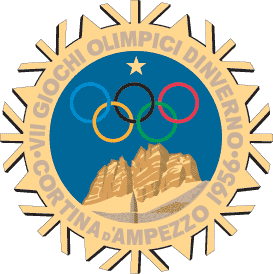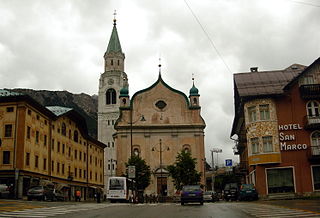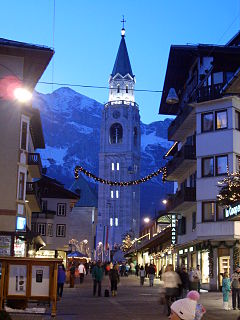
The 1956 Winter Olympics, officially known as the VII Olympic Winter Games, was a multi-sport event held in Cortina d'Ampezzo, Italy, from 26 January to 5 February 1956.

San Vito di Cadore is a small town and comune in the province of Belluno in the Italian region of Veneto. It is 9 kilometres (6 mi) from Cortina d'Ampezzo in the Dolomites and is next to Monte Antelao.
The 1944 Winter Olympics, which would have been officially known as the V Olympic Winter Games, were to have been celebrated in February 1944 in Cortina d'Ampezzo, Italy. Cortina d'Ampezzo had been awarded the games in June 1939, but with the onset of World War II, the 1944 Winter Olympics were cancelled in 1941.

Toblach is a comune/Gemeinde (municipality) in South Tyrol in northern Italy, located in the Puster Valley about 70 kilometres (43 mi) northeast of the city of Bolzano, on the border with Austria.
The IBSF World Championships, part of the International Bobsleigh and Skeleton Federation, have taken place on an annual basis in non-Winter Olympic years since 1930. A two-man event was included in 1931 with a combined championship occurring in 1947. Men's skeleton was introduced as a championship of its own in 1982 while women's bobsleigh and skeleton events were introduced in 2000. Both the women's bobsleigh and skeleton events were merged with the men's bobsleigh events at the 2004 championships. A mixed team event, consisting of one run each of men's skeleton, women's skeleton, 2-man bobsleigh, and 2-women bobsleigh debuted in 2007.

The FIBT World Championships 2011 took place 14 February – 27 February 2011 in Königssee, Germany, for the fifth time, doing so previously in 1979, 1986, and 1990 (skeleton), and 2004. In 2007, the championships were awarded to Cortina d'Ampezzo, Italy over Winterberg Germany, but Cortina withdrew in February 2009 to issues with the city of Cortina.
For the 1956 Winter Olympics in Cortina d'Ampezzo, Italy, a total of eight sports venues were used. All of the venues used were new or rebuilt. To make use of television coverage for the first time in the Winter Olympics, the cross-country skiing stadium was constructed to allow the best coverage. Five of the venues used for these games would appear in the James Bond film For Your Eyes Only twenty-five years later.
Cortina Airport is an abandoned airport located in Cortina d'Ampezzo, Veneto, Italy.
Alverà is an Italian surname. Notable people with the surname include:

Bolzano Bellunese is an Italian village, hamlet (frazione) of Belluno, in the Veneto.

Sacrario militare di Pocol is a cemetery and shrine near Passo Falzarego, in the locality of Pocol in the comune of Cortina d'Ampezzo in the Veneto region of northern Italy. The small church and cemetery were built in 1916 as a military cemetery by the 5th Alpine group. A shrine was built in 1935 as memorial to the thousands who died during World War I on the Dolomite front. It is a massive square tower of stone, clearly visible from the entire Ampezzo valley below. The remains of 9,707 Italian soldiers and 37 Austro-Hungarian soldiers are buried in the shrine. In a crypt in the centre of the structure rests the body of general Antonio Cantore, who was awarded the gold medal for military valor.

Castello di Botestagno is a ruined medieval fort in the comune of Cortina d'Ampezzo in the southern (Dolomitic) Alps of the Veneto region of Northern Italy. It is perched on a rock in the valley of the Boite River, a little further north of Cortina, in the town of Prà del Caštel.

Basilica Minore dei Santi Filippo e Giacomo is a Roman Catholic basilica located in Cortina d'Ampezzo, Italy. It is dedicated to the Apostles Philip and James, patron saint of Cortina d'Ampezzo. It is the home of the parish and the deanery of Cortina d'Ampezzo. Built between 1769 and 1775 in the Baroque style to a design by the architect Joseph Promperg, it sits on the site where two previous churches had existed from the 13th and 16th centuries.
Rinaldo Zardini Palaeontology Museum is a palaeontological museum in Cortina d'Ampezzo, Italy. It is one of three museums administered by Le Regole d'Ampezzo, the other two being the Mario Rimoldi Modern Art Museum and the Regole of Ampezzo Ethnographic Museum. It is also a member of "DOMUS, the Network of Science Museums of the Veneto Dolomites". The paleontology museum opened in August 1975, exhibits Dolomite fossils. The museum bears the name of Rinaldo Zardini, a local researcher, who collected the materials and catalogued them. Thousands of his findings are part of the collections, though he collected over 1,000,000 articles in his lifetime.
Mario Rimoldi Modern Art Museum is a contemporary and modern art museum in Cortina d'Ampezzo, Italy. It is one of three museums administered by Le Regole d'Ampezzo, the other two being the Rinaldo Zardini Palaeontology Museum and the Regole of Ampezzo Ethnographic Museum. It opened in 1974 after a donation from Rosa Braun, the widow of Mario Rimoldi. Rimoldi's collection was displayed in 1941, it moved to the Regole d'Ampezzo in 1963, and by 1995, the collection contained 364 works of art. The museum's permanent exhibition includes works by Filippo De Pisis, Felice Carena, Pio Semeghini, Renato Guttuso, Tullio Garbari, and Massimo Campigli. The museum is also used as a venue for live music performances.
Regole of Ampezzo Ethnographic Museum is an ethnographic museum in Cortina d'Ampezzo, Italy. It is one of three museums administered by Le Regole d'Ampezzo, the other two being the Mario Rimoldi Modern Art Museum and the Rinaldo Zardini Palaeontology Museum. It is situated in the renovated and redesigned sawmill of Pontechiesa covering two floors and a basement, which includes a classroom. The space was designed by Studio Gellner, 2006-2011, with lighting design by iGuzzini.

Milan–Cortina d'Ampezzo 2026 is a bid for the 2026 Winter Olympics by the cities of Milan and Cortina d'Ampezzo and the Italian National Olympic Committee. The IOC will select the host city for the 2026 Winter Olympics at the 134th IOC Session in Lausanne, Switzerland on June 24, 2019.












